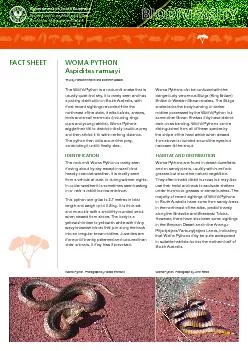

Gover Resources Management Board WOMA PYTHON Aspidites ramsayi FACT SHEET The Woma Python is a nocturnal snake that is usually quiet and shy It is rarely seen and has a patchy distribution in Sout ID: 841424
Download Pdf The PPT/PDF document "nment of South Australia" is the property of its rightful owner. Permission is granted to download and print the materials on this web site for personal, non-commercial use only, and to display it on your personal computer provided you do not modify the materials and that you retain all copyright notices contained in the materials. By downloading content from our website, you accept the terms of this agreement.
1 Gover nment of South Australia Resources
Gover nment of South Australia Resources Management Board WOMA PYTHON Aspidites ramsayi FACT SHEET The Woma Python is a nocturnal snake that is usually quiet and shy. It is rarely seen and has a patchy distribution in South Australia, with most recent sightings recorded from the north-east of the state. It eats lizards, snakes, birds and small mammals (including dingo pups and young rabbits). Woma Pythons wiggle their tail to distract initially cautious prey and then attract it to within striking distance. The python then coils around the prey, IDENTIFICATION The nocturnal Woma Python is rarely seen moving about by day except in warm and heavily overcast weather. It is mostly seen from a vehicle at dusk or during warmer nights. In cooler weather it is sometimes seen basking in or near a rabbit burrow entrance. This python can grow to 2.7 metres in total length and weigh up to 5.8 kg. It is thick set and muscular with a smoothly rounded snout when viewed from above. The body is a yellowish brown to yellowish white with many wavy brownish bands that join along the back more prominently patterned and coloured than older animals. It may hiss if provoked. Woma Pythons can be confused with the dangerously venomous Mulga (King Brown) Snake or Western Brown snakes. The Mulga snake lacks the body banding or darker midline possessed by the Woma Python but some other Brown Snakes may have distinct dark cross banding. Woma Pythons can be distinguished from all of these species by the shape of the head which when viewed from above is rounded around the eyes but narrower at the snout. HABITAT AND DISTRIBUTION Woma Pythons are found in desert dune�elds and on sandy plains, usually with hummock grasses but also other natural vegetation. They often inhabit rabbit burrows but may also use their head and neck to excavate shelters under hummock grasses or dense bushes. The majority of recent sightings of Woma Pythons in South Australia have come from sandy areas in the north-east of the state, predominantly along the Birdsville and Strzelecki Tracks. However, there have also been some sightings in the Simpson Desert and in the Anangu- Pitjantjatjara/Yankunytjatjara Lands, indicating that Woma Pythons may be quite widespread in suitable habitats across the northern half of South Australia. Text by Harald Ehmann and Michelle Watson. Woma Python. Photograph by Harald Ehmann. Woma Python. Photograp
2 h by John Read. WOMA PYTHON DISTRIBUTION
h by John Read. WOMA PYTHON DISTRIBUTION ACROSS AUSTRALIA KNOWN DISTRIBUTION IN SOUTH AUSTRALIA POTENTIAL THREATS TO WOMA PYTHON Land clearance and introduced predators Woma Python in central northern New South Wales and the south east of Queensland, and its near extinction in southwestern Western Australia. It is thought that local declines and extinctions of native prey including reptiles and mammals may have contributed to the Woma Python’s present-day patchy and fragmented distribution. Woma Pythons compete with cats and foxes and may also be eaten by these species, particularly when the snakes are still young and small. Their tendency to shelter in rabbit burrows may lead to them being unintentionally killed by warren ripping and fumigation. CURRENT RESEARCH Further research into the essential ecology of the Woma Python is needed. An up-to-date assessment of the distribution, density and age structure of the Woma Python population(s) is being made to ascertain the species conservation status and risk. As this species behaves in relatively predictable ways, uses easily recognised shelter sites, and leaves distinctive tracks in the sand individuals can be easily tracked once located. Should you have one of these rarely-seen pythons living nearby you may be interested in monitoring its movements for one or two seasons to aid this research. HOW CAN YOU HELP? If you have seen a Woma Python within or beyond the locations shown on the distribution map please let us know. Please note the location (a GPS or map reference would be most helpful) to assist the relocation of the site. A description of the habitat would also be helpful. To report observations or for further information about Woma Pythons or this study, please contact the South Australian Arid Lands Natural Resources Management Board 8648 5977. RESOURCES Ehmann, H. (2006). South Australian Rangelands and Aboriginal Lands Wildlife Management Manual: a resource handbook. Department of Water, Land and Biodiversity Conservation, South Australia. CONTACT US South Australian Arid Lands Natural Resources Management Board www.saalnrm.sa.gov.au P. (08) 8648 5977 E. aridlands@saalnrm. sa.gov.au Printed on 100% Australian recycled paper Distribution MarlaOodnadattaPort AugustCeduna DistributioADELAIDE Distribution MarlaOodnadattaPort AugustCeduna DistributioADELAIDE Map courtesy of DWLBC Updated July 2011